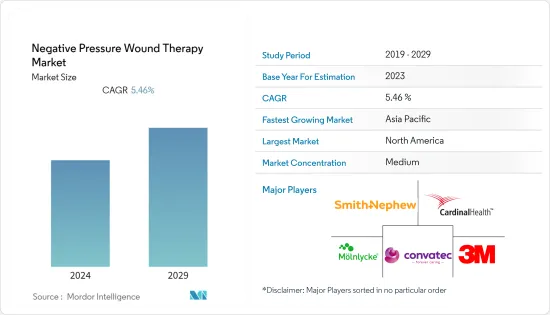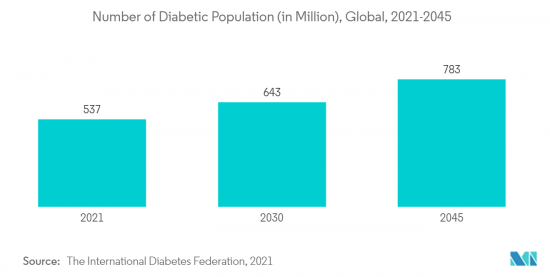
|
市場調査レポート
商品コード
1404312
陰圧創傷治療:市場シェア分析、産業動向と統計、2024~2029年の成長予測Negative Pressure Wound Therapy - Market Share Analysis, Industry Trends & Statistics, Growth Forecasts 2024 - 2029 |
||||||
カスタマイズ可能
適宜更新あり
|
|||||||
| 陰圧創傷治療:市場シェア分析、産業動向と統計、2024~2029年の成長予測 |
|
出版日: 2024年01月04日
発行: Mordor Intelligence
ページ情報: 英文 115 Pages
納期: 2~3営業日
|
全表示
- 概要
- 目次
陰圧創傷治療市場規模は2024年の27億米ドルから2029年には35億米ドルに成長し、予測期間中のCAGRは5.46%を記録する見込みです。

COVID-19パンデミックは市場の成長に大きな影響を与えました。全国的な封鎖により、道路に出る人の数は減少し、事故や負傷者の数も激減しました。例えば、Wound Repair and Regenerationが2021年10月に発表した論文によると、レベル2~5のエビデンスにより、慢性的な四肢を脅かす虚血などの重篤なケースを除き、患者を在宅にとどめ、クリニックへの直接訪問や入院の回数を最小限に抑えるために、遠隔医療と在宅医療のハイブリッドモデルへと創傷治療のパラダイムシフトが進んでいることが明らかになった。したがって、上記のすべての要因から、COVID-19が陰圧創傷治療市場に顕著な影響を与えたことがわかる。しかし、パンデミックは現在沈静化しているため、本調査の予測期間中、市場はパンデミック以前のレベルの成長を遂げると予想されます。
陰圧創傷治療(陰圧創傷治療)は、特に深部の急性創傷や下腿潰瘍などの持続性慢性創傷に対する治療法として最も好まれています。市場全体の成長を促す要因としては、事故や外傷の増加、糖尿病性足潰瘍などの慢性創傷の増加、陰圧創傷治療機器の技術進歩などが挙げられます。
慢性創傷は感染、潰瘍、血液供給不足などの合併症を引き起こし、創傷治癒期間を長引かせる。最も一般的な慢性創傷には、静脈性潰瘍、糖尿病性足潰瘍、褥瘡などがあります。国際糖尿病連合(IDF)の2022年最新情報によると、2021年には約5億3,700万人の成人(20~79歳)が糖尿病を患っています。糖尿病患者の総数は、2030年には6億4,300万人、2045年には7億8,300万人に増加すると予測されています。さらに、IDF 2021の報告書によると、糖尿病性足潰瘍は世界で4,000万人から6,000万人に影響を及ぼしています。その結果、糖尿病性足潰瘍の有病率の増加により、市場は成長する可能性が高いです。また、感染した創傷に陰圧創傷治療を局所的に使用することで、創傷の排膿、血管新生の促進、プロテイナーゼの排泄、局所と全身の細菌量の減少などの利点が得られます。
さらに、2021年8月にSage Journalsが発表した研究では、静脈性下腿潰瘍(VLU)は慢性下腿潰瘍全体の70%を占め、10年後の再発率は60~70%であると報告しています。深部静脈潰瘍は、下肢から右心房への静脈還流の90%を担っています。このような病態の再発は陰圧創傷治療デバイスの必要性を生み出し、市場の成長を促進すると予想されます。
さらに、さまざまな市場参入企業による発展も、市場の成長を後押しすると期待されています。例えば、2022年3月、Cork MedicalはMedTech Solutions Group(MTSG)とパートナーシップを締結しました。この契約により、MTSGは米国を除くすべての国でCork Medicalの国際的な陰圧創傷治療(陰圧創傷治療)事業を管理することになります。このような戦略的イニシアチブは市場の成長を後押しすると期待されています。
このように、慢性創傷の高い有病率や市場参入企業による発展など、上述の要因により、陰圧創傷治療市場は予測期間中に大きな成長が見込まれています。しかし、機器や治療費の高さが市場の成長を抑制する可能性があります。
陰圧創傷治療市場の動向
糖尿病性足潰瘍セグメントが予測期間中に大きな市場シェアを占める見込み
糖尿病性足潰瘍は、糖尿病患者に発生する開放性のただれや創傷で、一般的に足の底に生じます。陰圧創傷治療(陰圧創傷治療)の使用は、糖尿病性足潰瘍の創床肉芽形成を早めるのに効果的であることが判明しました。糖尿病性足潰瘍における陰圧創傷治療の適用が増加していることから、この分野は予測期間中に大きな成長が見込まれます。
さらに、国際糖尿病連合(International Diabetes Federation)の糖尿病アトラス(Diabetes Atlas)2022年2月報告書によると、2021年には欧州地域で推定6,100万人の成人(20~79歳)が糖尿病を患っていました。成人の糖尿病患者数は、2045年までに13%増の6,900万人に達すると予測されています。欧州地域における全年齢層の糖尿病有病率の急増は、糖尿病性足潰瘍の症例を増加させ、最終的にこのセグメントの成長を増大させると考えられます。世界的に糖尿病性足潰瘍の患者数が増加しているため、陰圧創傷治療器に対する需要が高まっています。陰圧創傷治療器は、糖尿病性足潰瘍を治療する最も効果的で安全かつ費用対効果の高い方法の1つであるためです。
さらに、陰圧創傷治療の重要性を実証する研究が増えていることも、同分野の成長を促進すると予想されます。例えば、Burns & Traumaが2021年6月に発表した論文では、糖尿病性足部の治療には分野横断的かつ体系的なアプローチが必要であり、その中で陰圧創傷治療は糖尿病性足部創傷の重要な補助的治療法であると結論付けています。また、陰圧創傷治療の標準化された管理と適用により、創傷滲出液の排出が改善し、血液灌流が促進され、創傷治癒が促進されると報告しています。
したがって、陰圧創傷治療が糖尿病性足潰瘍を短期間で治癒させる効果があることから、陰圧創傷治療の需要は増加しています。さらに、世界中で糖尿病性足潰瘍の発生率と有病率が上昇していることも、同分野の成長を後押ししています。したがって、この市場セグメントは予測期間中に大きな成長を示すと予想されます。

予測期間中、北米が市場で大きなシェアを占める見込み
北米は、慢性創傷の有病率の上昇と事故件数の増加により、陰圧創傷治療市場で大きな市場シェアを占めると予想されます。米国は最も経済が発展し、技術的に進んだ国の1つであるため、調査対象市場の注目すべきシェアを占めています。
この地域では糖尿病の負担が大きいことも、市場の成長を促進すると予想されます。例えば、国際糖尿病連合によると、2021年の北米における糖尿病有病者(20~79歳)は3,220万人で、2045年には3,680万人に達すると予測されています。このような糖尿病負担の増加は、糖尿病性足潰瘍のリスクを高めるため、市場の成長を促進すると予想されます。
さらに、市場参入企業による戦略的な取り組みが、同地域の市場成長を促進すると期待されています。例えば、2021年4月、Joerns HealthcareはMedelaと販売契約を締結し、Medelaの陰圧創傷治療(陰圧創傷治療)製品ラインを熟練看護師や長期急性期病院向けに全国規模で販売することになった。また、市場競争はユーザーエクスペリエンスを重視しています。
このように、慢性創傷の有病率の上昇や市場参入企業の戦略的イニシアティブなど、上記の要因により、調査対象市場は予測期間中に北米地域で大きな成長を示すと予想されます。
陰圧創傷治療産業概要
陰圧創傷治療市場は、ほとんどの国際企業が参入しており、競争は中程度です。市場シェアの面では、現在数社の大手企業が市場を独占しています。現在市場を独占している企業には、3M、Smith & Nephew、Molnlycke Health Care AB、Covatec Inc.、Cardinal Healthなどがあります。
その他の特典:
- エクセル形式の市場予測(ME)シート
- 3ヶ月間のアナリストサポート
目次
第1章 イントロダクション
- 調査の前提条件と市場定義
- 調査範囲
第2章 調査手法
第3章 エグゼクティブサマリー
第4章 市場力学
- 市場概要
- 市場促進要因
- 事故や外傷の増加
- 糖尿病性足部などの慢性創傷の増加
- 陰圧創傷治療デバイスの技術進歩
- 市場抑制要因
- デバイスと治療にかかるコストの高さ
- 陰圧創傷治療デバイスに関連する合併症
- ポーターのファイブフォース分析
- 供給企業の交渉力
- 買い手/消費者の交渉力
- 新規参入業者の脅威
- 代替品の脅威
- 競争企業間の敵対関係の強さ
第5章 市場セグメンテーション(市場規模-米ドル)
- 製品別
- 再利用可能デバイス
- 単回使用デバイス
- 創傷タイプ別
- 糖尿病性足潰瘍
- 褥瘡
- 静脈性下腿潰瘍
- 熱傷
- その他の創傷タイプ
- エンドユーザー別
- 病院
- 在宅医療
- その他のエンドユーザー
- 地域別
- 北米
- 米国
- カナダ
- メキシコ
- 欧州
- ドイツ
- 英国
- フランス
- イタリア
- スペイン
- その他の欧州
- アジア太平洋
- 中国
- 日本
- インド
- オーストラリア
- 韓国
- その他のアジア太平洋
- 中東・アフリカ
- GCC諸国
- 南アフリカ
- その他の中東とアフリカ
- 南米
- ブラジル
- アルゼンチン
- その他の南米
- 北米
第6章 競合情勢
- 企業プロファイル
- 3M
- Talley Group Ltd
- Smith & Nephew
- Otivio(FlowOx)
- Molnlycke Health Care AB
- Medela AG
- DeRoyal Industries Inc.
- ConvaTec Inc.
- Cardinal Health
- Paul Hartmann AG
第7章 市場機会と今後の動向

The Negative Pressure Wound Therapy Market size is expected to grow from USD 2.7 billion in 2024 to USD 3.5 billion by 2029, registering a CAGR of 5.46% during the forecast period.
The COVID-19 pandemic had a significant impact on the growth of the market. With the nationwide lockdowns, the number of people getting on the roads declined, and there was a drastic decrease in the number of accidents and injuries. For instance, as per the article published by Wound Repair and Regeneration in October 2021, levels 2-5 evidence revealed a paradigm shift in wound care toward hybrid telemedicine and home healthcare models to keep patients at home to minimize the number of in-person visits at clinics and hospitalizations, except in severe cases such as chronic limb-threatening ischemia. Hence, all the factors mentioned above showed that COVID-19 had a notable impact on the negative pressure wound therapy market. However, as the pandemic has currently subsided, the market is expected to experience pre-pandemic levels of growth during the forecast period of the study.
Negative pressure wound therapy (NPWT) is the most preferred choice of treatment, especially for deep acute wounds and persistent chronic wounds, including leg ulcers. Some of the factors that are driving the overall market growth are the increasing number of accidents and traumatic events, rising chronic wounds such as diabetic foot ulcers, and technological advancements in NPWT devices.
Chronic wounds lead to complications such as infection, ulceration, and insufficient blood supply, thus prolonging the wound healing period. The most common chronic wounds include venous ulcers, diabetic foot ulcers, and pressure ulcers. As per the 2022 update from the International Diabetic Federation (IDF), approximately 537 million adults (20-79 years) were living with diabetes in 2021. The total number of people living with diabetes is projected to rise to 643 million by 2030 and 783 million by 2045. Moreover, as per the IDF 2021 report, diabetic foot ulcers affect 40 to 60 million people globally. As a result, the market is likely to grow due to the increased prevalence of diabetic foot ulcers. Also, the localized use of negative pressure wound therapy in infected wounds offers advantages such as wound drainage, angiogenesis stimulation, proteinase excretion, and decreased local and systemic bacterial load.
Moreover, the study published by Sage Journals in August 2021 reported that venous leg ulcers (VLU) account for 70% of all chronic leg ulcers and are associated with a recurrence rate of 60-70% at 10 years. The deep venous ulcers are responsible for 90% of the venous return to the right atrium from the lower extremities. Such a recurrence of the condition creates the need for NPWT devices and is thus expected to drive the growth of the market.
Additionally, the developments by various market players are also expected to boost the market growth. For instance, in March 2022, Cork Medical entered into a partnership with MedTech Solutions Group (MTSG). As per the agreement, MTSG will manage Cork Medical's international negative pressure wound therapy (NPWT) business in all countries except the United States. Such strategic initiatives are expected to boost the growth of the market.
Thus, due to the above-mentioned factors such as the high prevalence of chronic wounds and the developments by market players, the negative pressure wound therapy market is expected to grow at a significant rate during the forecast period. However, the high cost of devices and treatment can restrain the market's growth.
Negative Pressure Wound Therapy Market Trends
Diabetic Foot Ulcers Segment is Expected to Have a Significant Market Share During the Forecast Period
A diabetic foot ulcer is an open sore or wound that occurs in patients with diabetes and is commonly located on the bottom of the foot. The use of negative pressure wound therapy (NPWT) was found to be effective in achieving faster wound bed granulation in diabetic foot ulcers. Due to the increased application of NPWT in diabetic foot ulcers, this segment is expected to project significant growth over the forecast period.
Moreover, according to the International Diabetes Federation Diabetes Atlas, February 2022 report, an estimated 61 million adults (20-79 years) were living with diabetes in the Europe Region in 2021. The number of adults with diabetes is predicted to rise to 69 million by 2045, an increase of 13%. The surge in the prevalence of diabetes among all ages in the European Region is likely to increase the cases of diabetic foot ulcers, which will ultimately augment the segment's growth. Due to the increasing number of people with diabetic foot ulcers globally, there is a growing demand for negative pressure wound therapy devices, as it is one of the most efficacious, safe, and cost-effective methods of treating diabetic foot ulcers.
Additionally, the growing number of studies demonstrating the importance of NPWT is also expected to propel the growth of the segment. For instance, an article published by Burns & Trauma in June 2021 concluded that the treatment of diabetic foot requires a cross-disciplinary and systematic approach, within which NPWT is an important adjunct treatment for diabetic foot wounds. It also reported that the standardised management and application of NPWT may improve wound exudate drainage, enhance blood perfusion, and promote wound healing.
Hence, due to the efficacy of negative pressure wound therapy in healing diabetic foot ulcers in less time, the demand for negative pressure wound therapy is increasing. Adding to that, the rising incidence and prevalence of diabetic foot ulcers across the globe also fuel the segment's growth. Thus, the market segment is expected to show significant growth over the forecast period.

North America is Expected to Hold a Significant Share in the Market Over the Forecast Period
North America is expected to hold a significant market share in the negative pressure wound therapy market due to the rising prevalence of chronic wounds and the increased number of accidents in this region. The United States, being one of the most developed economies and technologically advanced countries, holds a notable share of the studied market.
The high burden of diabetes in the region is also expected to drive the growth of the market. For instance, according to the International Diabetes Federation, in 2021, there were 32.2 million prevalent cases of diabetes (20-79 years old) in North America, and this is expected to reach 36.8 million by 2045. Such an increasing burden of diabetes raises the risk of diabetic foot ulcer and is thus expected to drive the growth of the market.
Additionally, the strategic initiatives taken by the market players are expected to drive the growth of the market in the region. For instance, in April 2021, Joerns Healthcare signed a distribution agreement with Medela to distribute Medela's negative pressure wound therapy (NPWT) product line on a national basis to skilled nursing and long-term acute care hospital settings. Also, the market players are focusing on user experience to gain a competitive edge.
Thus, owing to the abovementioned factors, such as the rising prevalence of chronic wounds and the strategic initiatives by market players, the studied market is expected to show significant growth in the North American region over the forecast period.
Negative Pressure Wound Therapy Industry Overview
The market for negative pressure wound therapy is moderately competitive with the presence of most international companies. In terms of market share, a few of the major players are currently dominating the market. Some of the companies which are currently dominating the market are 3M, Smith & Nephew, Molnlycke Health Care AB, Covatec Inc., Cardinal Health, and others.
Additional Benefits:
- The market estimate (ME) sheet in Excel format
- 3 months of analyst support
TABLE OF CONTENTS
1 INTRODUCTION
- 1.1 Study Assumptions and Market Definition
- 1.2 Scope of the Study
2 RESEARCH METHODOLOGY
3 EXECUTIVE SUMMARY
4 MARKET DYNAMICS
- 4.1 Market Overview
- 4.2 Market Drivers
- 4.2.1 Increasing Number of Accidents and Traumatic Events
- 4.2.2 Rising Incidence of Chronic Wounds Such as Diabetic Foot
- 4.2.3 Technological Advancements in the NPWT Devices
- 4.3 Market Restraints
- 4.3.1 High Cost of Device and Treatment
- 4.3.2 Complications Associated With NPWT Device
- 4.4 Porter's Five Force Analysis
- 4.4.1 Bargaining Power of Suppliers
- 4.4.2 Bargaining Power of Buyers/Consumers
- 4.4.3 Threat of New Entrants
- 4.4.4 Threat of Substitute Products
- 4.4.5 Intensity of Competitive Rivalry
5 MARKET SEGMENTATION (Market Size by Value - USD)
- 5.1 By Product
- 5.1.1 Reusable Device
- 5.1.2 Single-use Device
- 5.2 By Wound Type
- 5.2.1 Diabetic Foot Ulcer
- 5.2.2 Pressure Ulcer
- 5.2.3 Venous Leg Ulcer
- 5.2.4 Burn Wounds
- 5.2.5 Other Wound Types
- 5.3 By End User
- 5.3.1 Hospitals
- 5.3.2 Homecare
- 5.3.3 Other End Users
- 5.4 Geography
- 5.4.1 North America
- 5.4.1.1 United States
- 5.4.1.2 Canada
- 5.4.1.3 Mexico
- 5.4.2 Europe
- 5.4.2.1 Germany
- 5.4.2.2 United Kingdom
- 5.4.2.3 France
- 5.4.2.4 Italy
- 5.4.2.5 Spain
- 5.4.2.6 Rest of Europe
- 5.4.3 Asia-Pacific
- 5.4.3.1 China
- 5.4.3.2 Japan
- 5.4.3.3 India
- 5.4.3.4 Australia
- 5.4.3.5 South Korea
- 5.4.3.6 Rest of Asia-Pacific
- 5.4.4 Middle East and Africa
- 5.4.4.1 GCC
- 5.4.4.2 South Africa
- 5.4.4.3 Rest of Middle East and Africa
- 5.4.5 South America
- 5.4.5.1 Brazil
- 5.4.5.2 Argentina
- 5.4.5.3 Rest of South America
- 5.4.1 North America
6 COMPETITIVE LANDSCAPE
- 6.1 Company Profiles
- 6.1.1 3M
- 6.1.2 Talley Group Ltd
- 6.1.3 Smith & Nephew
- 6.1.4 Otivio (FlowOx)
- 6.1.5 Molnlycke Health Care AB
- 6.1.6 Medela AG
- 6.1.7 DeRoyal Industries Inc.
- 6.1.8 ConvaTec Inc.
- 6.1.9 Cardinal Health
- 6.1.10 Paul Hartmann AG

